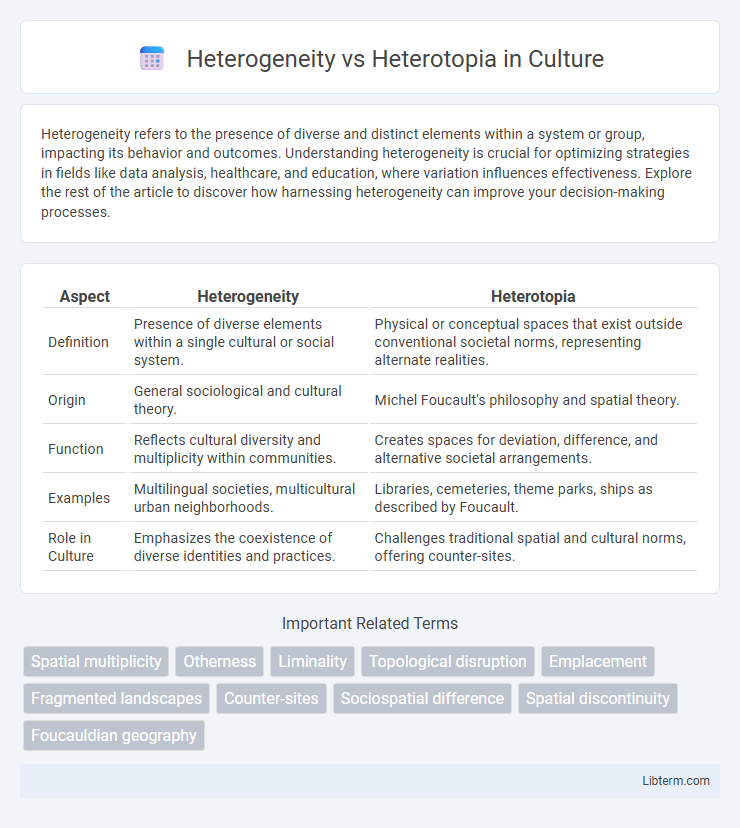Heterogeneity refers to the presence of diverse and distinct elements within a system or group, impacting its behavior and outcomes. Understanding heterogeneity is crucial for optimizing strategies in fields like data analysis, healthcare, and education, where variation influences effectiveness. Explore the rest of the article to discover how harnessing heterogeneity can improve your decision-making processes.
Table of Comparison
| Aspect | Heterogeneity | Heterotopia |
|---|---|---|
| Definition | Presence of diverse elements within a single cultural or social system. | Physical or conceptual spaces that exist outside conventional societal norms, representing alternate realities. |
| Origin | General sociological and cultural theory. | Michel Foucault's philosophy and spatial theory. |
| Function | Reflects cultural diversity and multiplicity within communities. | Creates spaces for deviation, difference, and alternative societal arrangements. |
| Examples | Multilingual societies, multicultural urban neighborhoods. | Libraries, cemeteries, theme parks, ships as described by Foucault. |
| Role in Culture | Emphasizes the coexistence of diverse identities and practices. | Challenges traditional spatial and cultural norms, offering counter-sites. |
Understanding Heterogeneity: Definition and Origins
Heterogeneity refers to the state of being diverse in character or content, originating from the Greek word "heteros," meaning different, and "genos," meaning kind. It encompasses variations and differences within a system, population, or set, often used in fields such as biology, sociology, and data science to describe complex, non-uniform structures. Understanding heterogeneity involves recognizing the multiple distinct components that coexist and interact, shaping a multifaceted and dynamic environment.
What is Heterotopia? Exploring Foucault’s Concept
Heterotopia refers to Michel Foucault's concept of real places that exist outside traditional social norms, embodying spaces of contradiction, disruption, and alternative order. Unlike heterogeneity, which signifies diversity and difference across elements or groups, heterotopia specifically describes spaces where multiple, sometimes conflicting, realities coexist simultaneously. Examples include gardens, cemeteries, or museums, which function as 'other spaces' that reflect or contest cultural norms and social structures.
Key Differences Between Heterogeneity and Heterotopia
Heterogeneity refers to the quality or state of being diverse in character or content within a particular system or group, emphasizing variation and differences among components. Heterotopia, a term coined by Michel Foucault, describes real places that exist outside conventional norms, characterized by layers of meaning, juxtaposition, and altered social functions. The key difference lies in heterogeneity focusing on diversity and multiplicity within a set, while heterotopia involves spatial or conceptual sites that contrast and challenge typical social and cultural structures.
The Role of Space and Diversity in Heterogeneity
Heterogeneity emphasizes the multiplicity and variation within spaces, highlighting how diverse elements coexist without forming a singular identity. It focuses on the role of spatial differences in creating complex, non-uniform environments where diversity drives dynamic interactions. In contrast, heterotopia involves different spaces that function as places of otherness, reflecting and contesting societal norms.
Heterotopia as Alternative Spaces: Real-World Examples
Heterotopia, as conceptualized by Michel Foucault, refers to real-world alternative spaces that exist outside conventional societal norms, such as cemeteries, gardens, and museums, where multiple layers of meaning intersect. These spaces challenge traditional spatial boundaries by juxtaposing incompatible sites within a single location, offering an embodied experience of social and cultural heterogeneity. Unlike heterogeneity, which emphasizes diversity and variation within a system, heterotopia is spatially and socially constructed to function as a mirror or counter-site reflecting broader cultural realities.
Intersections: Where Heterogeneity Meets Heterotopia
Heterogeneity refers to the diverse, multifaceted nature of social, cultural, or spatial elements within a given context, while heterotopia describes distinct, often paradoxical spaces that exist outside conventional norms. The intersection of heterogeneity and heterotopia occurs where diverse identities, narratives, and practices converge in alternative spaces that challenge dominant spatial and social orders. These intersections reveal complex layers of meaning and resistance, showcasing how varied experiences and spatial juxtapositions redefine power, identity, and belonging.
Impacts on Urban Planning and Architecture
Heterogeneity in urban planning emphasizes diverse land uses, social groups, and architectural styles, fostering inclusive environments that address varied community needs and enhance resilience. Heterotopia introduces alternative spaces reflecting social, cultural, or political otherness within the urban fabric, challenging conventional spatial orders and encouraging innovative design approaches. Both concepts impact architecture by promoting complexity and multiplicity, enabling adaptive reuse, mixed-use developments, and the creation of spaces that engage multiplicity of identities and functions.
Sociocultural Implications of Both Concepts
Heterogeneity reflects the diversity within social groups, emphasizing variations in culture, identity, and experiences that shape dynamic, multifaceted societies. Heterotopia, a concept introduced by Michel Foucault, denotes distinct social spaces that function as 'other' or alternate realities, challenging conventional norms and allowing coexistence of conflicting cultural practices. Both concepts highlight how sociocultural complexity disrupts uniformity, influencing identity formation, social interactions, and power structures in contemporary communities.
Contemporary Applications in Art and Literature
Heterogeneity in contemporary art and literature manifests through the diverse, multifaceted narratives and mixed media techniques that challenge monolithic perspectives. Heterotopia, as conceptualized by Michel Foucault, describes spaces of otherness that disrupt conventional realities, influencing site-specific art installations and liminal narrative structures. Both concepts facilitate critical engagement with identity, space, and cultural plurality, enriching contemporary creative practices.
Future Perspectives: Navigating Diversity and Spatial Theory
Future perspectives on heterogeneity emphasize the dynamic interplay of diverse cultural, social, and biological elements within evolving systems, promoting adaptability and resilience. In contrast, heterotopia offers a critical spatial theory framework that redefines spaces as sites of difference and deviation from normative societal structures, revealing new modes of human experience and interaction. Integrating heterogeneity with heterotopia can enhance urban planning, digital environments, and social policies by embracing multiplicity and challenging homogeneous spatial constructs.
Heterogeneity Infographic

 libterm.com
libterm.com